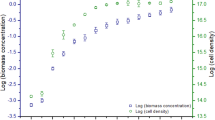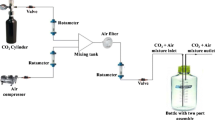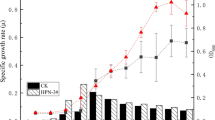Abstract
Mixotrophic cultivation using organic carbon sources has become increasingly important for large-scale production and application of microalgae, as it can overcome the current commercial bottleneck of low yield or high cost associated with photoautotrophic and heterotrophic cultivation. In this study, we investigated the effects of adding two acetate forms, sodium acetate (NaAc) and ammonium acetate (NH4Ac), at different concentrations (2, 4, 6, 8, 10 and 12 g L−1) on the biomass, biochemical components content (pigments, proteins, soluble sugars and lipids) and fatty acid composition of Chlorella vulgaris 31 (Cv-31) under mixotrophic conditions. Our results showed that the addition of NaAc significantly increased the biomass and lipid content of microalgae compared with NH4Ac, with 10 g L−1 NaAc having the best effect on the growth and lipid synthesis. Furthermore, only 2 and 4 g L−1 NaAc promoted the synthesis of pigments in algal cells, while all concentrations of NH4Ac were inhibitory. In contrast to pigments, the effect of two acetates on protein synthesis was opposite, being promoted by low concentrations of NH4Ac. Both acetates had a "low concentration promotion, high concentration inhibition" effect on the synthesis of soluble sugars. Moreover, the percentage of saturated fatty acids in the fatty acid profile increased with the amount of NaAc supplementation, while stearic acid and oleic acid appeared. Our findings suggest that regulating the type and concentration of acetate can improve the biomass and lipid yield of Cv-31 to promote the microalgal biomass production.







Similar content being viewed by others
Data availability
Data will be made available on request.
References
Abeliovich A, Azov Y (1976) Toxicity of ammonia to algae in sewage oxidation ponds. Appl Environ Microbiol 31:801–806
Abreu AP, Morais RC, Teixeira JA, Nunes J (2022) A comparison between microalgal autotrophic growth and metabolite accumulation with heterotrophic, mixotrophic and photoheterotrophic cultivation modes. Renew Sustain Energy Rev 159:112247
Adesanya VO, Davey MP, Scott SA, Smith AG (2014) Kinetic modelling of growth and storage molecule production in microalgae under mixotrophic and autotrophic conditions. Bioresour Technol 157:293–304
Allakhverdiev SI, Nishiyama Y, Takahashi S, Miyairi S, Suzuki I, Murata N (2005) Systematic analysis of the relation of electron transport and ATP synthesis to the photodamage and repair of photosystem II in Synechocystis. Plant Physiol 137:263–273
Andersen RA (2013) The microalgal cell. In: Richmond A, Hu Q (eds) Handbook of Microalgal Culture: Biotechnology and applied phycology. Wiley & Sons, New York, pp 3–20
Bajguz A (2009) Brassinosteroid enhanced the level of abscisic acid in Chlorella vulgaris subjected to short-term heat stress. J Plant Physiol 166:882–886
Borowitzka MA (2016) Algal physiology and large-scale outdoor cultures of microalgae. In: Borowitzka MA, Beardall J, Raven JA (eds) The Physiology of Microalgae. Springer, Cham, pp 601–652
Byreddy AR, Gupta A, Barrow CJ, Puri M (2016) A quick colorimetric method for total lipid quantification in microalgae. J Microbiol Methods 125:28–32
Castillo T, Ramos D, García-Beltrán T, Brito-Bazan M, Galindo E (2021) Mixotrophic cultivation of microalgae: An alternative to produce high-value metabolites. Biochem Eng J 176:108183
Chai WS, Tan WG, Halimatul Munawaroh HS, Gupta VK, Ho S-H, Show PL (2021) Multifaceted roles of microalgae in the application of wastewater biotreatment: A review. Environ Pollut 269:116236
Chambonniere P, Ramírez-Romero A, Dimitriades-Lemaire A, Sassi J-F, Delrue F (2022) Photosynthetic carbon uptake correlates with cell protein content during Lipid accumulation in the microalga Chlorella vulgaris NIES 227. Fermentation 8:614
Chandra R, Rohit MV, Swamy YV, Venkata Mohan S (2014) Regulatory function of organic carbon supplementation on biodiesel production during growth and nutrient stress phases of mixotrophic microalgae cultivation. Bioresour Technol 165:279–287
Chen B, Wan C, Mehmood MA, Chang J-S, Bai F, Zhao X (2017) Manipulating environmental stresses and stress tolerance of microalgae for enhanced production of lipids and value-added products–a review. Bioresour Technol 244:1198–1206
Chen H, Wang Q (2021) Regulatory mechanisms of lipid biosynthesis in microalgae. Biol Rev Camb Phil Soc 96:2373–2391
Cheng C-L, Lo Y-C, Huang K-L, Nagarajan D, Chen C-Y, Lee D-J, Chang J-S (2022) Effect of pH on biomass production and carbohydrate accumulation of Chlorella vulgaris JSC-6 under autotrophic, mixotrophic, and photoheterotrophic cultivation. Bioresour Technol 351:127021
Cheng D, He Q (2014) Assessment of environmental stresses for enhanced microalgal biofuel production–an overview. Front Energy Res 2:26
Cheng J, Fan W, Zheng L (2021) Development of a mixotrophic cultivation strategy for simultaneous improvement of biomass and photosynthetic efficiency in freshwater microalga Scenedesmus obliquus by adding appropriate concentration of sodium acetate. Biochem Eng J 176:108177
Cho HU, Kim YM, Choi Y-N, Xu X, Shin DY, Park JM (2015) Effects of pH control and concentration on microbial oil production from Chlorella vulgaris cultivated in the effluent of a low-cost organic waste fermentation system producing volatile fatty acids. Bioresour Technol 184:245–250
Chu WL, Phang SM, Goh SH (1995) Influence of carbon source on growth, biochemical composition and pigmentation of Ankistrodesmus convolutus. J Appl Phycol 7:59–64
Collos Y, Harrison PJ (2014) Acclimation and toxicity of high ammonium concentrations to unicellular algae. Mar Pollut Bull 80:8–23
de Morais MG, Vaz Bda S, de Morais EG, Costa JA (2015) Biologically active metabolites synthesized by microalgae. Biomed Res Int 2015:835761
Dragone G (2022) Challenges and opportunities to increase economic feasibility and sustainability of mixotrophic cultivation of green microalgae of the genus Chlorella. Renew Sustain Energy Rev 160:112284
Dubois M, Gilles HA, Hamilton JK, Rebers PA, Smith F (1956) Colorimetric method for determination of sugars and related substances. Anal Chem 28:22–25
Gutierrez J, Kwan TA, Zimmerman JB, Peccia J (2016) Ammonia inhibition in oleaginous microalgae. Algal Res 19:123–127
Harun R, Singh M, Forde GM, Danquah MK (2010) Bioprocess engineering of microalgae to produce a variety of consumer products. Renew Sust Energy Rev 14:1037–1047
Heifetz PB, Förster B, Osmond CB, Giles LJ, Boynton JE (2000) Effects of acetate on facultative autotrophy in Chlamydomonas reinhardtii assessed by photosynthetic measurements and stable isotope analyses. Plant Physiol 122:1439–1445
Heredia-Arroyo T, Wei W, Ruan R, Hu B (2011) Mixotrophic cultivation of Chlorella vulgaris and its potential application for the oil accumulation from non-sugar materials. Biomass Bioenergy 35:2245–2253
Hu Q (2013) Environmental effects on cell composition. In: Richmond A, Hu Q (eds) Handbook of microalgal culture: biotechnology and applied phycology. Wiley & Sons, New York, pp 114–122
Juneja A, Ceballos RM, Murthy GS (2013) Effects of environmental factors and nutrient availability on the biochemical composition of algae for biofuels production: A review. Energies 6:4607–4638
Källqvist T, Svenson A (2003) Assessment of ammonia toxicity in tests with the microalga, Nephroselmis pyriformis, Chlorophyta. Water Res 37:477–484
Khalid AAH, Yaakob Z, Abdullah SRS, Takriff MS (2019) Assessing the feasibility of microalgae cultivation in agricultural wastewater: the nutrient characteristics. Environ Technol Innov 15:100402
Kim Y, Lama S, Agrawal D, Kumar V, Park S (2021) Acetate as a potential feedstock for the production of value-added chemicals: metabolism and applications. Biotechnol Adv 49:107736
Kong WB, Yang H, Cao YT, Song H, Hua SF, Xia CGR (2013) Effect of glycerol and glucose on the enhancement of biomass, lipid and soluble carbohydrate production by Chlorella vulgaris in mixotrophic culture. Food Technol Biotechnol 51:62–69
Kong WB, Yang SL, Wang H, Huo HR, Guo BM, Liu N, Zhang AM, Niu SQ (2020) Regulation of biomass, pigments, and lipid production by Chlorella vulgaris 31 through controlling trophic modes and carbon sources. J Appl Phycol 32:1569–1579
Kumar R, Hegde AS, Sharma K, Parmar P, Srivatsan V (2022) Microalgae as a sustainable source of edible proteins and bioactive peptides-current trends and future prospects. Food Res Int 157:111338
Lacroux J, Seira J, Trably E, Bernet N, Steyer JP, van Lis R (2021) Mixotrophic growth of Chlorella sorokiniana on acetate and butyrate: interplay between substrate, C:N ratio and pH. Front Microbiol 12:703614
Lacroux J, Trably E, Bernet N, Steyer JP, van Lis R (2020) Mixotrophic growth of microalgae on volatile fatty acids is determined by their undissociated form. Algal Res 47:101870
Li L, Lollar BS, Li H, Wortmann UG, Lacrampe-Couloume G (2012) Ammonium stability and nitrogen isotope fractionations for NH4+–NH3(aq)–NH3(gas) systems at 20–70°C and pH of 2–13: Applications to habitability and nitrogen cycling in low-temperature hydrothermal systems. Geochim Cosmochim Acta 84:280–296
Liu N, Zhang H, Zhao J, Xu Y, Ge F (2020) Mechanisms of cetyltrimethyl ammonium chloride-induced toxicity to photosystem II oxygen evolution complex of Chlorella vulgaris F1068. J Hazard Mater 383:121063
Liu X, Duan S, Li A, Xu N, Cai Z, Hu Z (2009) Effects of organic carbon sources on growth, photosynthesis, and respiration of Phaeodactylum tricornutum. J Appl Phycol 21:239–246
Loke Show P (2022) Global market and economic analysis of microalgae technology: status and perspectives. Bioresour Technol 357:127329
Matos J, Cardoso C, Bandarra NM, Afonso C (2017) Microalgae as healthy ingredients for functional food: a review. Food Funct 8:2672–2685
Mehta AK, Chakraborty S (2021) Multiscale integration of mixotrophic microalgal cultivation, lipid synthesis, rapid biomass harvesting, and nutrient recycling in pilot-scale photobioreactors. Algal Res 53:102146
Morais WG Jr, Gorgich M, Corrêa PS, Martins AA, Mata TM, Caetano NS (2020) Microalgae for biotechnological applications: cultivation, harvesting and biomass processing. Aquaculture 528:735562
Orús MI, Marco E, Martínez F (1991) Suitability of Chlorella vulgaris UAM 101 for heterotrophic biomass production. Bioresour Technol 38:179–184
Pancha I, Chokshi K, Maurya R, Trivedi K, Patidar SK, Ghosh A, Mishra S (2015) Salinity induced oxidative stress enhanced biofuel production potential of microalgae Scenedesmus sp. CCNM 1077. Bioresour Technol 189:341–348
Patel A, Krikigianni E, Rova U, Christakopoulos P, Matsakas L (2022) Bioprocessing of volatile fatty acids by oleaginous freshwater microalgae and their potential for biofuel and protein production. Chem Eng J 438:135529
Qiu R, Gao S, Lopez PA, Ogden KL (2017) Effects of pH on cell growth, lipid production and CO2 addition of microalgae Chlorella sorokiniana. Algal Res 28:192–199
Russell C, Rodriguez C, Yaseen M (2022) High-value biochemical products & applications of freshwater eukaryotic microalgae. Sci Total Environ 809:151111
Safi C, Zebib B, Merah O, Pontalier P-Y, Vaca-Garcia C (2014) Morphology, composition, production, processing and applications of Chlorella vulgaris: a review. Renew Sust Energy Rev 35:265–278
Schiel-Bengelsdorf B, Dürre P (2012) Pathway engineering and synthetic biology using acetogens. FEBS Lett 586:2191–2198
Schuchmann K, Müller V (2014) Autotrophy at the thermodynamic limit of life: A model for energy conservation in acetogenic bacteria. Nat Rev Microbiol 12:809–821
Shen Y, Qiu S, Chen Z, Zhang Y, Trent J, Ge S (2020) Free ammonia is the primary stress factor rather than total ammonium to Chlorella sorokiniana in simulated sludge fermentation liquor. Chem Eng J 397:125490
Shetty P, Gitau MM, Maróti G (2019) Salinity stress responses and adaptation mechanisms in eukaryotic green microalgae. Cells 8:1657
Shi Y, Sheng J, Yang F, Hu Q (2007) Purification and identification of polysaccharide derived from Chlorella pyrenoidosa. Food Chem 103:101–105
Singh R, Upadhyay AK, Chandra P, Singh DP (2018) Sodium chloride incites reactive oxygen species in green algae Chlorococcum humicola and Chlorella vulgaris: Implication on lipid synthesis, mineral nutrients and antioxidant system. Bioresour Technol 270:489–497
Smith RT, Gilmour DJ (2018) The influence of exogenous organic carbon assimilation and photoperiod on the carbon and lipid metabolism of Chlamydomonas reinhardtii. Algal Res 31:122–137
Song M, Pei H (2018) The growth and lipid accumulation of Scenedesmus quadricauda during batch mixotrophic/heterotrophic cultivation using xylose as a carbon source. Bioresour Technol 263:525–531
Tam NFY, Wong YS (1996) Effect of ammonia concentrations on growth of Chlorella vulgaris and nitrogen removal from media. Bioresour Technol 57:45–50
Wahidin S, Idris A, Shaleh SRM (2013) The influence of light intensity and photoperiod on the growth and lipid content of microalgae Nannochloropsis sp. Bioresour Technol 129:7–11
Wang J, Yang H, Wang F (2014a) Mixotrophic cultivation of microalgae for biodiesel production: Status and prospects. Appl Biochem Biotechnol 172:3307–3329
Wang LL, Tao Y, Mao XZ (2014b) A novel flat plate algal bioreactor with horizontal baffles: Structural optimization and cultivation performance. Bioresour Technol 164:20–27
Yeh K-L, Chang J-S (2012) Effects of cultivation conditions and media composition on cell growth and lipid productivity of indigenous microalga Chlorella vulgaris ESP-31. Bioresour Technol 105:120–127
Yu L, Li T, Ma J, Zhao Q, Wensel P, Lian J, Chen S (2022) A kinetic model of heterotrophic and mixotrophic cultivation of the potential biofuel organism microalgae Chlorella sorokiniana. Algal Res 64:102701
Yuan X, Kumar A, Sahu AK, Ergas SJ (2011) Impact of ammonia concentration on Spirulina platensis growth in an airlift photobioreactor. Bioresour Technol 102:3234–3239
Zhuang DL, He N, Khoo KS, Ng E-P, Chew KW, Ling TC (2022) Application progress of bioactive compounds in microalgae on pharmaceutical and cosmetics. Chemosphere 291:132932
Funding
This work was supported by Higher Education Industry Support Plan Project of Gansu Province, China (2020C-21; 2021CYZC-37), Key Research and Development Program of Gansu Province (22YF7NA118), Incubation Programme for Key Scientific Research Project of Northwest Normal University (NWNU-LKZD2022-02).
Author information
Authors and Affiliations
Contributions
Shuting Peng: Investigation, Data curation, Methodology, Visualization, Writing-original draft, Writing-review & editing. Yueqin Cao: Investigation, Data curation, Methodology, Visualization, Writing-original draft, Writing-review & editing. Zijian Xie: Investigation, Methodology, Formal analysis, Writing-review & editing. Xiaoyun Zhang: Investigation, Methodology, Formal analysis, Writing-review & editing. Saimai Ma: Investigation, Methodology, Formal analysis, Writing-review & editing. Weibao Kong: Conceptualization, Methodology, Resources, Funding acquisition. Resources, Formal analysis, Validation, Project administration, Writing-original draft, Writing-review & editing.
Corresponding author
Ethics declarations
Competing interests
The authors declare that they have no known competing financial interests or personal relationships that could have appeared to influence the work reported in this paper.
Additional information
Publisher's Note
Springer Nature remains neutral with regard to jurisdictional claims in published maps and institutional affiliations.
Shuting Peng and Yueqin Cao are the co-first author.
Rights and permissions
Springer Nature or its licensor (e.g. a society or other partner) holds exclusive rights to this article under a publishing agreement with the author(s) or other rightsholder(s); author self-archiving of the accepted manuscript version of this article is solely governed by the terms of such publishing agreement and applicable law.
About this article
Cite this article
Peng, S., Cao, Y., Xie, Z. et al. Effects of sodium acetate and ammonium acetate on the growth and production of cellular components of Chlorella vulgaris 31. J Appl Phycol 36, 1–14 (2024). https://doi.org/10.1007/s10811-023-03149-y
Received:
Revised:
Accepted:
Published:
Issue Date:
DOI: https://doi.org/10.1007/s10811-023-03149-y




